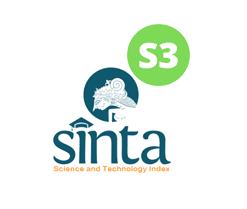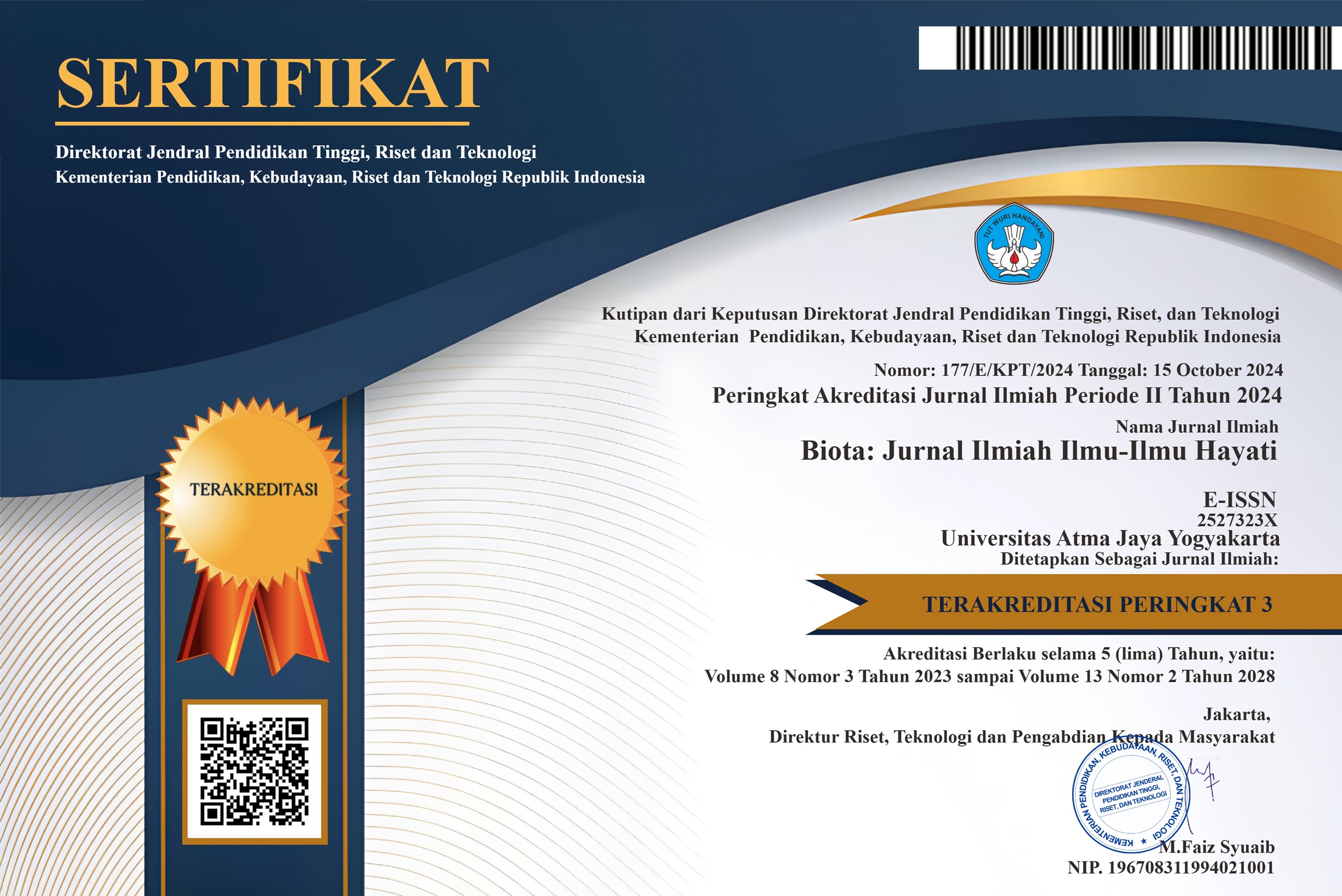Utilization of Used Cardboard and Vegetable Waste as Growth Media for White Oyster Mushroom (Pleurotus ostreatus)
DOI:
https://doi.org/10.24002/biota.v6i2.4278Keywords:
Pleurotus ostreatus, biological efficiency, yield, cardboard, vegetable wasteAbstract
White oyster mushroom (Pleurotus ostreatus) is a highly nutritious food with simple cultivation process using sawdust as its main substrate. Nowadays, availability of sawdust become a problem for some mushroom farmers. Cardboard and vegetable wastes are easily found and difficult to maintain. Based on their characteristics, those wastes can be used as mushroom growth media. This study aims to determine the effect of cardboard and vegetable waste on mushroom growth and the best media composition to obtain maximum productivity. Those wastes are used as the main substrate in eleven composition variations with complete randomized design (CRD) analysis method using One-Way ANOVA and simple linear regression statistical test. The results showed, variations in media composition affect the condition of the media which then influence the growth of P. ostreatus. Maximum productivity was found in media composition XI with mycelium growth rate up to 3.91 cm/day, media IX with the biological efficiency up to 45.38%, and media X with the highest total yield up to 97.28 grams. From this study it can be concluded that cardboard and vegetable waste can be an alternative growth substrate for P. ostreatus in urban areas with a maximum concentration of vegetable waste no more than 30% by weight of the media used.
References
Ahmed, M., Abdullah, N., Ahmed, K. U., & Borhannuddin Bhuyan, M. H. M. (2013). Yield and Nutritional Composition of Oyster Mushroom Strains Newly Introduced in Bangladesh. Pesquisa Agropecuaria Brasileira, 48(2), 197–202. https://doi.org/10.1590/S0100-204X2013000200010
Cahyana, Y. A., Muchroji, dan M. Bakrun. (2001). Jamur Tiram. Penebar Swadaya, Jakarta
Chang, S. T. & Philip G. Miles. (2004). Mushrooms: Cultivation, Nutritional Value, Medicinal Effect, and Environmental Impact 2nd Edition. CRC Press, New York, USA
Dewilda, Y. & F. L. Darfyolanda. (2017). Pengaruh Komposisi Bahan Baku Kompos (Sampah Organik Pasar, Ampas Tahu, dan Rumen Sapi) Terhadap Kualitas dan Kuantitas Kompos. Jurnal Teknik Lingkungan UNAND, 14(1):52–61
Dahmardeh, M. (2013). Use of Oyster Mushroom ( Pleurotus ostreatus ) Grown on Different Substrates ( Wheat and Barley Straw ) and Supplemented at Various Levels of Spawn to Change the Nutritional Quality Forage. 3(4), 138–140. https://doi.org/10.5923/j.ijaf.20130304.02
Fujian, X., Hongzhang, C., & Zuohu, L. (2001). Solid-State Production of Lignin Peroxidase (LiP) and Manganese Peroxidase (MnP) by Phanerochaete chrysosporium Using Steam-Exploded Straw As Substrate. Bioresource Technology, 80(2), 149–151. https://doi.org/10.1016/S0960-8524(01)00082-7
Hakiki, A., Purnomo, A. S., Kimia, J., Matematika, F., Alam, P., &
Tiram, A. P. J. (2013). Pengaruh Tongkol Jagung Sebagai Media Pertumbuhan Terhadap Kualitas Jamur Tiram (Pleurotus ostreatus). Jurnal Sains Dan Seni Pomits, 1(1), 1–4
Hariadi, Nurul, Lilik Setyobudi, dan Nihayati Ellis. (2013). Studi Pertumbuhan dan Hasil Produksi Jamur Tiram Putih (Pleorotus ostreatus) pada Media Tumbuh Jerami Padi dan Serbuk Gergaji. Jurnal Produksi Tanaman, 1(1), 47–53
Kadam, R. M., Patil, S. S., & Jadhav, B. S. (2008). Production of Protein by Fungi, Pleurotus Species from Different Agricultural Wastes. International Journal of Plant Protection, 1(2), 45–47
Kalmis, E., Azbar, N., Yildiz, H., & Kalyoncu, F. (2008). Feasibility of Using Olive Mill Effluent (OME) As A Wetting Agent During The Cultivation of Oyster Mushroom, Pleurotus ostreatus, on Wheat Straw. Bioresource Technology, 99(1), 164–169. https://doi.org/10.1016/j.biortech.2006.11.042
Khan, M. A., Amin S. M. R., Uddin M. N., Tania M., and Alam N. (2008). Comparative Study of the Nutritional Composition of Oyster Mushrooms Cultivated in Bangladesh. Bangladesh J Mushroom. 2: 9-14
Kirom, B. (2015). Mengukur Kinerja Pelayanan dan Kepuasan Konsumen. Pustaka Reka Cipta, Bandung
Kulshreshtha, S., Mathur, N., Bhatnagar, P., & Kulshreshtha, S. (2013). Cultivation of Pleurotus citrinopileatus on Handmade Paper and Cardboard Industrial Wastes. Industrial Crops and Products, 41(1), 340–346. https://doi.org/10.1016/j.indcrop.2012.04.053
Li, W., Li, X., Yang, Y., Zhou, F., Liu, Y., Zhou, S., & Yu, H. (2015). Effects of Different Carbon Sources and C/N Values on Nonvolatile Taste Components of Pleurotus eryngii. International Journal of Food Science and Technology, 50(11), 2360–2366. https://doi.org/10.1111/ijfs.12901
Mandeel, Q. A., Al-Laith, A. A., & Mohamed, S. A. (2005). Cultivation of Oyster Mushrooms (Pleurotus spp.) on Various Lignocellulosic Wastes. World Journal of Microbiology and Biotechnology, 21(4), 601–607. https://doi.org/10.1007/s11274-004-3494-4
Muktiani, A., Tampoebolon, B., & Achmadi, J. (2007). The In Vitro Rumen Fermentability on the Processed Vegetable Waste. Journal of the Indonesian Tropical Animal Agriculture, 32(1), 44–50
Oei, P., Nieuwenhuijzen, B.V. 2005. Small-scale Mushroom Cultivation: Oyster, Shiitake, and Wood Ear Mushrooms. Agromisa Foundation and CTA, Wageningen.
Owaid, M. N., Abed, A. M., & Nassar, B. M. (2015). Recycling Cardboard Wastes to Produce Blue Oyster Mushroom Pleurotus ostreatus in Iraq. Emirates Journal of Food and Agriculture, 27(7), 537–541. https://doi.org/10.9755/ejfa.2015.04.118
Patel, H., Gupte, A., & Gupte, S. (2009). Effect of Different Culture Conditions and Inducers on Production of Laccase by A Basidiomycete Fungal Isolate Pleurotus ostreatus HP-1 Under Solid State Fermentation. BioResources, 4(1), 268–284. https://doi.org/10.15376/biores.4.1.268-284
Qiu, Z., Wu, X., Zhang, J., & Huang, C. (2017). High Temperature Enhances The Ability of Trichoderma asperellum to Infect Pleurotus ostreatus Mycelia. PLoS ONE, 12(10), 1–16. https://doi.org/10.1371/journal.pone.0187055
Rajapakse, J. C., Rubasingha P., Dissanayake N. N. (2007). The Potential of Using Cost-Effective Compost Mixtures for Oyster Mushroom (Pleurotus species) Cultivation in Sri Lanka. Tropical Agricultural Research and Extension. 10: 29–32
Singh, M. P., & Singh, V. K. (2012). Biodegradation of Vegetable and Agrowastes by Pleurotus sapidus: A Novel Strategy to Produce Mushroom with Enhanced Yield and Nutrition. Cellular and Molecular Biology, 58(1), 1–7. https://doi.org/10.1170/T913
Singh, V. K., & Singh, M. P. (2014). Bioremediation of Vegetable and Agrowastes by Pleurotus ostreatus: A Novel Strategy to Produce Edible Mushroom with Enhanced Yield and Nutrition. Cellular and Molecular Biology, 60(5), 2–6. https://doi.org/10.14715/cmb/2014.60.5.2
Stamets, P., & Chilton, J. S. (1983). The Mushroom Cultivator: A Practical Guide to Growing Mushrooms at Home. In S. Cal. L. Rev. https://doi.org/10.1002/mus.23999
Tzeng, D. S. (1974). Studies on Nutritional Requirements and the Improvement of Techniques in Cultivation of Straw Mushroom Volvariella volvariella (Bull. Ex Fr.) Sing. [M.Sci. Thesis]. Taichung (Taiwan): National Chung Hsing University
Urben, A.F. 2004. Produca˜o de Cogumelos por Meio de Tecnologia Chinesa Modificada. Embrapa Recursos Gene´ticos e Biotecnologia, Brası´lia (in Portuguese)
Yang, W. J., Guo, F. L., & Wan, Z. J. (2013). Yield and Size of Oyster Mushroom Grown on Rice/Wheat Straw Basal Substrate Supplemented with Cotton Seed Hull. Saudi Journal of Biological Sciences, 20(4), 333–338. https://doi.org/10.1016/j.sjbs.2013.02.006
Downloads
Published
How to Cite
Issue
Section
License
Copyright (c) 2021 Jovita Lavenia, Aniek Prasetyaningsih, Catarina Aprilia Ariestanti

This work is licensed under a Creative Commons Attribution-NonCommercial 4.0 International License.
Authors who publish with Biota : Jurnal Ilmiah Ilmu-Ilmu Hayati agree to the following terms:
- Authors retain copyright and grant the Biota : Jurnal Ilmiah Ilmu-Ilmu Hayati right of first publication. Licensed under a Creative Commons Attribution-NonCommercial 4.0 International License that allows others to share the work with an acknowledgment of the work's authorship and initial publication in this journal.
- Authors are able to enter into separate, additional contractual arrangements for the non-exclusive distribution of the journal's published version of the work (e.g., post it to an institutional repository or publish it in a book), with an acknowledgment of its initial publication in Biota : Jurnal Ilmiah Ilmu-Ilmu Hayati, and as long as Author is not used for commercial purposes.













